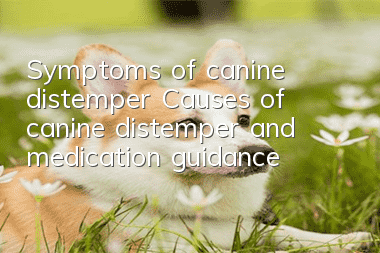Symptoms of canine distemper Causes of canine distemper and medication guidance

Introduction and causes of canine distemper
Canine distemper, commonly known as "canine distemper", is a highly contagious and fatal infectious disease in dogs caused by canine distemper virus. The mortality rate of this disease is very high, generally reaching more than 50% in adult dogs, and even reaching more than 80% in puppies after infection. This disease has a certain periodicity, often having a major epidemic every three years.1. Canine distemper is caused by canine distemper virus (CDV). Canine distemper virus has weak resistance to the external environment and is very sensitive to heat and drying. Drying and most disinfectants can kill the virus. It is also sensitive to ultraviolet light. This virus is not infectious to humans.
2. Canine distemper occurs frequently in the cold seasons of winter, spring and autumn and winter. The main reason is that the canine distemper virus can survive for a long time in low temperature environments. For example, under conditions of 2-4 degrees Celsius, canine distemper The virus can survive and remain infectious for weeks and can be stored for years after freeze-drying. This is also the main reason why canine distemper occurs more frequently in the cold seasons of winter, spring and autumn and winter.
3. Disease transmission is most likely to occur in places where dogs gather, such as pet shops, dog farms, stray dog shelters, etc.
4. Canine distemper can be infected at all ages, but most puppies within 2 months of age will not be infected due to maternal antibodies. Dogs aged 4 to 12 months have the highest incidence rate, with a mortality rate of 50%. and above; the incidence rate gradually decreases above 2 years of age. The symptoms of canine distemper vary in severity and are diverse.
Symptoms of canine distemper
1. Overall manifestations. The affected dog has a loss of appetite or simply refuses to eat, is lethargic, and changes in body temperature are biphasic, that is, the body temperature first rises to 39-41 degrees, lasting for 1 to 3 days, and then gradually subsides, approaching normal temperature, and occurs again a few days later. The body temperature rises and can lead to death in severe cases.2. Respiratory system type (pneumonia type). It manifests as rhinitis and conjunctivitis, with serous or mucopurulent discharge from the eyes and nose. If it causes ocular neuritis, it can lead to blindness. Viruses invade the lungs and cause interstitial pneumonia, and secondary bacterial infection can cause bronchopneumonia. Clinical manifestations include cough, dyspnea, and crepitus on auscultation.
3. Gastrointestinal type. Manifested by vomiting and diarrhea. The sick dog had severe diarrhea, occasionally passed bloody stools, and developed tenesmus.
4. Neurotype. Canine distemper virus can invade any part of the central nervous system. Clinically, neurological symptoms may appear simultaneously with other systemic symptoms or may appear subsequently. The main manifestations are general twitching, masticatory muscle spasm, turning in circles, and abnormal behavior. When the midbrain, cerebellum and vestibule are damaged, ataxia and abnormal posture are manifested. Spinal infection manifests as abnormal posture, abnormal spinal reflexes, paralysis, etc.
Treatment Plan for Canine Distemper
This part is for experienced pet owners. If you can prepare medicines and infusions, you can save yourself; it is recommended that most people skip reading. , don’t use medicine randomly at home, just read the end of the article.1. Use high-dose canine distemper hyperimmune serum, canine distemper monoclonal antibody and canine gamma globulin in the early stage of the disease. Canine distemper highSerum-free small dogs 5-10 ml each time, large dogs 20-40 ml each time, intramuscular injection or intravenous infusion, once a day for 3-5 consecutive days; canine distemper monoclonal antibody 5-20 ml, subcutaneous injection , once a day, for 3 consecutive days; canine gamma globulin for small dogs, 2 ml each time, and for large dogs, 4-6 ml, 2 times a day, for 3-5 consecutive days.
2. Use antiviral drugs. Polysarcoma 0.5-1 mg for small dogs, 1-2 mg for large dogs, intramuscular injection, once a day, for 3 to 5 consecutive days; Ribavirin can also be used, 50 mg for small dogs, 100 mg for large dogs, intramuscular injection, 2 times a day times, for 3 consecutive days.
3. Cardiotonic rehydration. For dogs with obvious symptoms of enteritis and severe vomiting, mixed intravenous infusion of Ringer's solution 30-50 mg/kg body weight, 10% calcium gluconate 2-5 ml, and vitamin B6 50-100 mg can be used.
4. Symptomatic treatment. If you have purulent rhinitis or severe nasal congestion, you can use a mixture of ephedrine, dexamethasone and kanamycin nasal drops for intranasal instillation; for sick dogs with dry cough or spasmodic cough, you can use Kekuaihao, aminophylline, and chlorpheniramine. Anti-cough and licorice tablets and other drugs can be used to relieve cough and reduce phlegm;
5. Supportive treatment. For dogs with a long course of disease and signs of weakness, 10 u/o glucose 30-50 mg/kg body weight can be intravenously supplemented, and vitamin C 500 mg, adenosine triphosphate 5-20 mg, cytochrome C 5 N 15 mg, and compound amino acid 100 can be added. -250ml, has a good effect on relieving the disease and improving the general condition.
Canine distemper is a very virulent virus. Even though some dogs can save their lives through timely treatment, they may also suffer from the sequelae of canine distemper, such as limb paralysis and constant convulsions.
Reference for medication for canine distemper
l. Ampicillin, antibacterial. 20-30 mg/kg body weight, oral administration, 2-3 times a day; 10-20 mg/kg body weight.2. Enrofloxacin, antibacterial, 2.5-5 mg/kg body weight, taken orally, twice a day.
3. Ciprofloxacin, antibacterial, 5-10 mg/kg body weight, taken orally, twice a day.
4. Qingkailing oral liquid, to clear away heat and detoxify, 0.2-0.4 ml/kg, 2 times a day.
5. Metoclopramide, antiemetic, 0.2-0.5 mg/kg body weight, taken orally, 3-4 times a day.
6. Aminophylline, dilates the trachea, 10-15 mg/kg body weight, taken orally, 2 to 3 times a day: Cough will clear, eliminate phlegm and relieve cough, 25 mg/time, taken orally, 2 to 3 times a day .
7. Dexamethasone, anti-inflammatory, 0.5 mg/kg body weight, taken orally, 2 times per session.
8. Chlorpromazine, sedative, 3 mg/kg body weight, taken orally, twice a day.
9. Phenytoin, for grand mal epilepsy, 100-200 mg/time, taken orally, 1-2 times a day.
Random articles
- What are the physical examination items for dogs? List of physical examination items for different ages
- Shar Pei Dog Breeding Do you know how to raise a Shar Pei dog?
- What's going on with the dog's butt mopping the floor? Do you understand the reason?
- Several fatal diseases in elderly dogs. Owners should pay attention to them
- Can dogs eat bananas? What fruits can dogs eat?
- How to treat depression in dogs? Your company is more important than depression medicine
- Why can’t puppies be bathed? Under what circumstances can dogs not be bathed?
- What are the benefits of eating bones for dogs? What bones should dogs not eat?
- If you don’t have symptoms of Alzheimer’s disease in dogs, take precautions as soon as possible
- How to tell whether a Schnauzer is pure or not? Teach you how to identify a purebred Schnauzer



